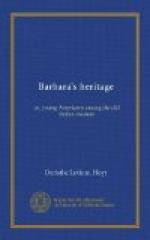“Yes, it is the spirit of pictures and their truth to nature that appeal to the mass of people here,” replied Mr. Sumner, “and so it must be everywhere. I have been very glad to read in my papers from home that free art exhibitions have been occasionally opened in the poor quarters of our cities. Should the movement become general, as I hope it will, it must work good in more than one direction. Not only could those who have hitherto been shut out from this means of pleasure and education receive and profit by it, but the art itself would gain a wholesome impulse. A new class of critics would be heard—those unversed in art-parlance—who would not talk of line, tone, color-harmonies and technique, but would go to the very heart of picture and painter; and I think the truest artists would listen to them and so gain something.
“But we must get to Giotto again. I have told you what he tried to paint, but you will see that he could not do all this in the least as if he had been taught in our art-schools of to-day. How little could Cimabue teach him! His hills and rocks are parodies of nature. He knew not how to draw feet, and would put long gowns or stockings on his people so as to hide his deficiency. He never could make a lying-down figure look flat. But how he could accomplish all that he did in his pictures is more than any one can explain.
“We will now look behind this grand tomb at the foot of the stairs and find two of Giotto’s frescoes. There you see the pictures—the Birth of the Virgin and the Meeting of St. Joachim and St. Anna, the father and mother of the Virgin. Do you know the story of these saints?”
“Yes,” answered Malcom, “Betty read it to us last evening, for, you see, uncle, we had been dipping just a bit, so as not to get below our depth, into Mr. Ruskin’s ‘Mornings in Florence’; so we ought to be able to understand something here, if anywhere, oughtn’t we?”
“Well, look and see what you can find! I wonder what will appeal first to each one of you!”
After a few minutes of complete silence Mr. Sumner said: “Margery dear, I wonder what you are thinking of?”
“I am thinking, Uncle, that, just as Mr. Ruskin says, I cannot help seeing the baby in this picture. At whatever part I look my eyes keep coming back to the dear little thing wrapped up so clumsily, whom the two nurses are tending so lovingly and with such reverence.”
“Yes, my dear, old Giotto knew how to make the chief thing in his pictures seem to be the most important; something that not all of us artists of to-day know how to do by any means.”
“But the pictures are so queer!” burst forth Malcom. “I do see some of the fine things of which you speak, Uncle Robert, but there are so many almost ridiculous things; the shepherds that are following St. Joachim—do look at the feet of the first one; and the second has on stockings. I can see the different lines that poor old Giotto drew when he was struggling over those first feet; I wonder if he put the others into stockings just to save trying to draw them. And the funny lamb in the arms of the first shepherd; and the queer, stiff sprigs of grass which are growing up in all sorts of places! and the angel coming out of the cloud! and—”




